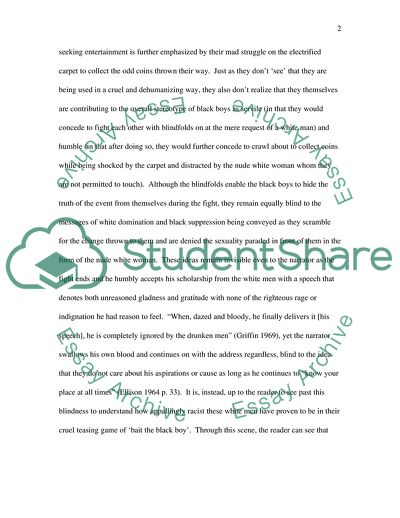Cite this document
(Ellison's Novel the Invisible Man Essay Example | Topics and Well Written Essays - 1500 words, n.d.)
Ellison's Novel the Invisible Man Essay Example | Topics and Well Written Essays - 1500 words. https://studentshare.org/literature/1703332-with-the-imagery-of-sight-and-blindness-ellison-reveals-the-theme-of-invisibility-by-displaying-the-lack-of-insight-ofthe-boys-in-the-battle-royal-brother
Ellison's Novel the Invisible Man Essay Example | Topics and Well Written Essays - 1500 words. https://studentshare.org/literature/1703332-with-the-imagery-of-sight-and-blindness-ellison-reveals-the-theme-of-invisibility-by-displaying-the-lack-of-insight-ofthe-boys-in-the-battle-royal-brother
(Ellison'S Novel the Invisible Man Essay Example | Topics and Well Written Essays - 1500 Words)
Ellison'S Novel the Invisible Man Essay Example | Topics and Well Written Essays - 1500 Words. https://studentshare.org/literature/1703332-with-the-imagery-of-sight-and-blindness-ellison-reveals-the-theme-of-invisibility-by-displaying-the-lack-of-insight-ofthe-boys-in-the-battle-royal-brother.
Ellison'S Novel the Invisible Man Essay Example | Topics and Well Written Essays - 1500 Words. https://studentshare.org/literature/1703332-with-the-imagery-of-sight-and-blindness-ellison-reveals-the-theme-of-invisibility-by-displaying-the-lack-of-insight-ofthe-boys-in-the-battle-royal-brother.
“Ellison'S Novel the Invisible Man Essay Example | Topics and Well Written Essays - 1500 Words”. https://studentshare.org/literature/1703332-with-the-imagery-of-sight-and-blindness-ellison-reveals-the-theme-of-invisibility-by-displaying-the-lack-of-insight-ofthe-boys-in-the-battle-royal-brother.


